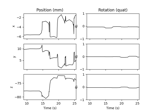mne.chpi.compute_chpi_amplitudes#
- mne.chpi.compute_chpi_amplitudes(raw, t_step_min=0.01, t_window='auto', ext_order=1, tmin=0, tmax=None, verbose=None)[source]#
Compute time-varying cHPI amplitudes.
- Parameters:
- rawinstance of
Raw Raw data with cHPI information.
- t_step_min
float Minimum time step to use.
- t_window
float Time window to use to estimate the amplitudes, default is 0.2 (200 ms).
- ext_order
int The external order for SSS-like interfence suppression. The SSS bases are used as projection vectors during fitting.
Changed in version 0.20: Added
ext_order=1by default, which should improve detection of true HPI signals.- tmin
float Start time of the raw data to use in seconds (must be >= 0).
- tmax
float|None End time of the raw data to use in seconds (cannot exceed data duration). If
None(default), the current end of the data is used.- verbosebool |
str|int|None Control verbosity of the logging output. If
None, use the default verbosity level. See the logging documentation andmne.verbose()for details. Should only be passed as a keyword argument.
- rawinstance of
- Returns:
- chpi_amplitudes
dict The time-varying cHPI coil amplitudes, with entries “times”, “proj”, and “slopes”.
- chpi_amplitudes
Notes
This function will:
Get HPI frequencies, HPI status channel, HPI status bits, and digitization order using
_setup_hpi_amplitude_fitting.Window data using
t_window(half before and half aftert) andt_step_min.Use a linear model (DC + linear slope + sin + cos terms) to fit sinusoidal amplitudes to MEG channels. It uses SVD to determine the phase/amplitude of the sinusoids.
In “auto” mode,
t_windowwill be set to the longer of:- Five cycles of the lowest HPI or line frequency.
Ensures that the frequency estimate is stable.
- The reciprocal of the smallest difference between HPI and line freqs.
Ensures that neighboring frequencies can be disambiguated.
The output is meant to be used with
compute_chpi_locs().New in v0.20.
